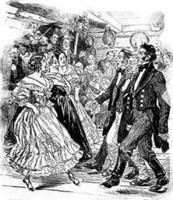
|
The Society of Folk Dance Historians (SFDH)
Hints on Teaching Contras
[
Home |
About |
Encyclopedia | CLICK IMAGE TO ENLARGE |

|
FORMATION OF SETS
You may wish your couples to promenade into a Contra set from a circle, or you may simply teach them how to form a set without any previous knowledge Have the couples, one behind the other, facing the head of the hall, the caller, and the music, the lady on the gentleman's right. Any number of couples may dance a Contra but there should be at least six couples in each set, and an even number of couples might simplify learning. Remember, the head of the set is closest to the caller, and the foot or bottom of the set is at the other end.
Now have partners face each other, each moving back so that there is a distance of about four to six feet between the men's line and the woman's line. Experienced dancers will take this position at once. When a Contra line is formed, however, the first couples form the head of the set and from then on other people joining the set do so by building the set toward the bottom. If there are as many as twelve couples, two sets might be formed instead of one.
STEP
A simple-light dance-walk with an occasional addition of individuality, especially on the balances, and when changing body direction.
In some contra dances, such as Petronella, the formation explained above, with all the men on one side and all the ladies on the other, is used. In others, such as Good Girl, Maple Leaf Jig, and Green Mountain Volunteers, the dance is done in a "Crossed-over" position, which is accomplished as follows:
Starting at the head of the set, the gentlemen count off one, two, one, two, all the way to the bottom. Now, the gentlemen who are numbers one exchange places with their partners. These people who have changed places are known as "Active Couples." Those who remained at home in the set are the "Inactive Couples." Cues or calls are directed to the "Active Couples." In this formation, there is an alternation of men and women on both sides of the set. This must be maintained throughout the dance and is accomplished as follows:
As an inactive couple finds themselves at the top of the set they stand out during one complete contra pattern, but must exchange places before the next pattern begins. Now they begin dancing the next pattern as an active couple. When an active couple reaches the foot of the set they will stand out one pattern, but change sides before the next pattern begins, and now they will be an inactive couple until they again reach the head of the set.
RHYTHM
Contra dancing flows from one figure to another as the phrases of the music command. In order to prompt-call a contra dance the person doing so should be sufficiently aware of the phrasing of the music to be able to give direction on the beats immediately preceding the beginning of the phrase intended for the dance figure.
EXAMPLE: If the caller wishes dancers to circle left, CIRCLE LEFT might be allowed two beats of music and should precede the beat on which the dancers start to circle. "Circle Left" should be called on beats 7 and 8 of the preceding phrase and the dancers begin to circle on count one of the following phrase.
EXAMPLE: ACTIVE COUPLES DO-SI-DO requires four counts or beats of music and would be called on beats 5, 6, 7, and 8 of the phrase preceding the phrase of eight counts which would be required to do the do-si-do.
There are many Contra dances, ranging from very simple to those which are much too complicated to use with beginner dancers. Although rooted in Irish, Scottish, and English dancing, Contras are an American tradition. There are some newly-composed contras, many of which are fun to do.
Be sure the dancers understand how a Contra set should look before active couples cross over so that both the actives and inactives will realize the role they have to play.
Mention that it is "normal and essential" to stand still with no dancing to do when reaching the top or bottom of the set. When partners standing out exchange places the dancing role or status also changes. Actives become inactives and vice versa.
CUES OR CALLS PRECEDE THE DANCE ACTION!
Dance to the music! Use light steps. Add a step-close-step, or a little jig if the music makes you feel like doing it, or, if you feel like it for any other good reason.
RELAX, ENJOY IT.
Swings are USUALLY long and EASY.
Almost every figure is done to a phrase of eight counts or multiples of eight, but eliminate any counting, if used at all, as soon as possible. The music tells us when to cue and when to dance.
DOCUMENTS
- Contra, an article.
- Country Dance, an article.
- Country Dance Book, a book.
- Country Dance and Song, a magazine.
- Country Dance and Song Society, an article.
- Contra Dance Book, a book.
As appearing in Northern Junket, February, 1958.
This page © 2018 by Ron Houston.
Please do not copy any part of this page without including this copyright notice.
Please do not copy small portions out of context.
Please do not copy large portions without permission from Ron Houston.